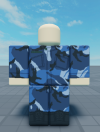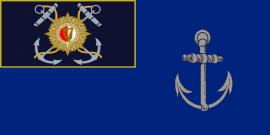Corkonian Coast Guard
| |||||||||||||||||||||||

|
This article is currently a work in progress. This article is in the process of developing its contents. Refrain from any edits to Corkonian Coast Guard,
without first contacting the main page editor.
|
The Royal Corkonian Coast Guard or the Corkonian Coast Guard, or just the Coast Guard, is the naval component of the Royal Corkonian Defence Forces, it comprises of a fleet air arm and a patrol fleet. The coast guard's main responsibility revolves around protecting and maintaining orders around Cork's coastline and ensuring no danger approaches shore.
The coast guard works with the navy and actively trains with them.
History
Creation
The Coastguard was established during the 2024 re-organisation, it was established due to the Corkonian Army 2024 Re-Organisation Act which set out to no longer make the navy the sole line of coast patrols and instead create a specific branch of the Defence Forces which was tasked with guarding the coast.
Funding was diverted from the navy and the navy did loose some ships however still works with the coast guard to train and prepare troops.
Uniform


The coast guard as of January 25th 2024 consists of two uniforms. The service dress, aka No.1s and formals aka No.2. Service dress is used for everything from PT to exercises to deployments. Formals are used on base when doing drill, general garrison or when not doing active duty.
No.1s
The No.1s camo pattern follows a blue DPM style, the camo is from the Kuwaitian navy's DPM. The uniform was adopted on the 25th January 2024 and was put into service since. Previously when the Navy was fully responsible for the patrolling of the coast, the coast guard always used naval No.8s (camos).
When wearing the No.1s the only gear attached is a DPM vest used to carry ammo, flag batch and a beret. The beret is of the wearers division, either that of patrol fleet, fleet air arm or civil arm. Only headgear the coast guard can expect to be equipped with is a beret.
The No.1s are not to be worn with a stable belt. Only members of the Fleet Air Arm are permitted to wear jumpsuits. Berets are to be worn at all time.
When wearing the No.1s the wearer will have a rank slide on their webbing. This rank slide is mandatory.
No.2s
The No.2s aka the formals are a set of uniform that are to be used on base, on public grounds and on parade. They are not to be worn in deployment or active duty unless garrisoning under specific situations. The formals are also used in training when conducting drill/marching. They were adopted on the 25th January 2024 and were put into service, all ranks are to wear the stablebelt with the formals.
Formals are also to be worn with beret, the only two permitted gears with formals are berets and stablebelts, the rest will go against uniform guidelines.
When wearing formals the wearer will have their rank either on their sleeve or shoulder.
When in formals, no individual unless given proper authorization is permitted to carry a gun. Only such authorizations are given when on garrison, when guarding or when in hostile areas.
Headwear



The Royal Coast Guard only wear berets, of which there are three. One for each division. The blue beret with a black background is for all members of the Patrol Fleet, this beret is the second least common given it's for specific deployed personnel, mostly on ships in hostile areas or in contested waters.
The second beret is for the fleet air arm, this beret is the least common as it is only for pilots, officers, engineers and other fleet air arm specific personnel.
The third beret is the most common one, it is for the civil arm division. This is the most common one to be found on ships, bases and other installations.
All headwear use the same capbadge, the one of the coast guard.
Divisions
Patrol Fleet
The Patrol Fleet is the main aspect of the coast guard, all ships are allocated to it. It will mainly consist of naval engineers, navigators, medicals, police, communications officers and more. When it comes to main functions on the ship it will be the Patrol Fleet's job.
When on active deployment, servicemen on ships are equipped with the standard Aug A1 rifle, however some may find themselves with the older FN Fal. All coastguard servicemen are additionally given a pistol if in hostile areas. All servicemen in the Patrol Fleet must undergo basic combat training and cqb training to qualify.
The Patrol Fleet is the main group that actually surveys the coast and patrols it.
Fleet Air Arm
The Fleet Air Arm is the division that handles all aviation. Not all members of the F.A.A are pilots however. The F.A.A majority wise is engineers/communications specialist/trainers and ground crew. The F.A.A mainly consists of helicopter aircraft with very few planes in it's stockpiles, all fixed wing aircraft are however logistics and transport. When it comes to rotary aircraft the majority are also logistics and transport which can be also used as patrol aircraft and rescue.
Civil Arm
The civilian arm is all service. It consists of logistics, engineering, transport. It involves the majority of the Coast Guard Reserve which are civilians which do the coast guard part time. Most of the civil arm are reserves. Civilian arm troops do not get trained with weaponry or combat and instead are taught specific trades such as logistics, engineering and more.
Ranks and Insignias
| Rank group | Non-commissioned officer | Enlisted | ||||||||||||||||||||||||||||||||||
|---|---|---|---|---|---|---|---|---|---|---|---|---|---|---|---|---|---|---|---|---|---|---|---|---|---|---|---|---|---|---|---|---|---|---|---|---|
| Insignia | 
|

|

|

|

|

|

|

|
No insignia | |||||||||||||||||||||||||||
| Abbreviation | Chief of the Coast Guard | Captain | Lieutenant | Warrant Officer | Petty Officer | Leading Rate | Able Seaman | Seaman | BT/AT | |||||||||||||||||||||||||||
The coastguard relatively speaking does not have many ranks (compared to other branches). This is because in the Corkonian Army 2024 Re-Organisation Act it stated the coastguard must have a simple top down authority that can ensure quick and dynamic changes: simple structure: simple spread out detachments and a ease of command.
The Chief of the Coast Guard if the overall commander of the coast guard and Captains build up the coast guard high command, a Captain will command the entirety of a county's coast guard. A Lieutenant commands a detachment, that be either a base or an outpost or an airfield, or they command a ship. There is only one WO per county and they act as the most senior enlisted to help out with the Captain and Lieutenants. There is one PO per detachment who is the 2I/C of the detachment/ship. A leading rate is the equivalent of a sergeant and commands a small group of enlistees. Able seamen are experienced seamen. Seamen are the backbone.
- BT means Basic Training
- AT means Awaiting Tryouts
Current Installations and Detachments
Detachments are ordered numerically and are not isolated to counties. A detachment could be either an airstrip, dockyard or a simple outpost. Not every detachment will house ships or aircraft or even either, some house both.
- A: Airfield
- D: Dockyard
- O: Outpost
- G: Garrison
- AD (airfield and dockyard)
An outpost is detachment that does not house aircraft or ships, they can have helipads and runways however an outpost is determined whether it houses that helicopter/plane long term or not. If the aircraft is not housed long term then it is deemed an outpost, same goes for if ships dock there. Outposts are usually put on islands or more isolated areas.
- County Donegal Coast Guard:
- 1st (Rathlin Island) Detachment (A)
- 2nd (Rathlin Island) Detachment (G)
- 3rd (Rathlin Island) Detachment (D)
- County Waterford Coast Guard:
- 2nd (Ardmore) Detachment (D)
Equipment
Here is a complete list of all the equipment used in the Corkonian Royal Coastguard
Current Equipment
| Name | Origin | Type | Caliber | Photo | Notes |
|---|---|---|---|---|---|
| Pistols | |||||
| Heckler & Koch USP | Semi-Automatic Pistol | 9x19mm | 
|
The USP entered service in the coast guard due to it being in large stockpiles across the airforce, navy, police and army. It is issued to all deployed personnel and there are no plans of retiring or replacing the gun. | |
| Assault Rifles | |||||
| Steyr AUG | Assault Rifle | 5.56×45mm | 
|
The Steyr Aug is standard issue rifle in the Corkonian coast guard, only issued to personnel in areas of tension. | |
| Rifles & Sniper rifles | |||||
| FN Fal | Battle Rifle | 7.62x51mm | 
|
The FN Fal is still in large use mainly by non-combat arms of the Corkonian Army, it is heavily used by the Airforce, Navy, Border Guard and Coast Guard. Additionally the FN Fal is still in active combat service. It is to be replaced by the Steyr AUG | |
| L115A3 | Sniper Rifle | 7.62×51mm (.308) | 
|
The L115A3 is the main sniper rifle of the Corkonian Army, after the Corkonian War of Independence and the 3rd-Cork Celtic War a lot of these were put in the stockpile. They are issued to sniper units and special forces. | |
| Machine Guns | |||||
| FN Mag | Machine Gun | 7.62×51mm | 
|
The FN Mag is the standard issue machine gun for all Corkonian Infantry men. Taken from Irish and Celtic Army stockpiles. Plans to be replaced by the M249 or MG4 have been seen but not acted on. | |
Active Ships
| Class | Picture | Type | Ships | No. | Comm. | Displacement | Note |
|---|---|---|---|---|---|---|---|
| Patrol vessels | |||||||
| LÉ Eithne Class (cn-1) | 
|
Offshore patrol vessel | CGS Kilcalf | CCG-OVN-01 | 2022 | 1,920 tonnes | Training craft. |
| CGS Kinsale | CCG-OVN-02 | 2024 | In reserve since January 2024. | ||||
| CGS Ballinlough | CCG-OVN-03 | 2024 | |||||
| CGS Bridgend | CCG-OVN-04 | 2024 | Planned to be decomissioned. | ||||
| LÉ Eithne Class (cn-2) | 
|
Offshore patrol vessel | CGS Danstown | CCG-OVN-05 | 2024 | 1,920 tonnes | |
| CGS Oolaville | CCG-OVN-06 | 2024 | |||||
| CGS Mitchelstown | CCG-OVN-07 | 2024 | |||||
| CGS Cardigen | CCG-OVN-08 | 2024 | |||||
Active Aircraft
No aircraft in the Corkonian Coastguard are fitted with guns, however some helicopters may be fitted with machine guns if needed.




